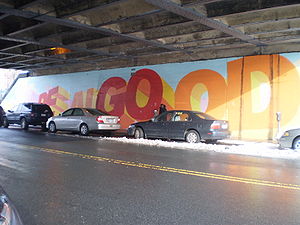From Queens: The Brand Residents Don't Buy
Back to History of Immigration
History of Rego Park
According to the Encyclopedia of New York City, before English settlers lived in Rego Park, that area of Queens was called Whitepot. The name originated from the Native American and English land purchase transaction 350 years ago, when the English bought the land for three clay white pots. Rego Park, adjacent to Forest Hills, was mostly farmland until the 1920's when the Real Good Construction Company bought land in this area and constructed over 500 homes (Forgotten NY).
The first families that lived in this suburbanized neighborhood were mostly German and Dutch immigrant farmers as noted by Nancy Foner in the ethnography New Immigrants in New York. From 1880 to the start of World War I, New York City experienced a great increase in Jewish immigrants from Eastern Europe. As a result of the construction of bridges and subways, more Jewish families were able to relocate to areas in Brooklyn and Queens, especially Rego Park. This neighborhood has long been a community of Jewish culture and was reinforced by a second wave of Jewish immigrants several decades later.
According to Foner, in the 1970s, Rego Park became home to many immigrants from the former Soviet Union. The largest group of Bukarian Jews came from Uzbekistan and Tajikistan. By the time of their arrival, most Jewish communities had settled in the Forest Hills-Rego Park area.
However, community life and assimilation between Russian émigrés and the old Jewish community was not always peaceful. The older Jewish community was comprised of mostly elderly people who spoke Yiddish and Hebrew. On the other hand, the new Jewish immigrants spoke Russian and raised their children under Russian cultural values, which was not recognized by the old Jewish immigrants. Due to their upward mobility, after several years of living in Rego Park, many Russian Jews moved away from this ethnic enclave, leaving behind “the elderly, the least educated and the illegal immigrants who continue to need the emotional and economic buffer zone that the enclaves provide” (Foner 113).
While Rego Park is still home to a large Jewish community, there are many immigrants from Colombia, South Korea, India and China. Almost 56% of the population is Caucasian, while about a quarter is Asian or Pacific Islander (New York Times).
On our walking tour of Rego Park, we were definitely aware of the large Jewish population. We visited the Jewish Center and met several women and listened to their immigration stories, including some that dated back to World War II. However, we also met people of many other nationalities, verifying our research about other people groups in the area. The Lost Battalion Hall, located in a busy area of Rego Park, close to the new shopping mall, is a place to which many young people of different backgrounds flock. Hispanic, white, black, and Asian youth find the Hall a good place for after school activities such as playing sports in the gym.
Based on the store signs and advertisements in Russian as seen in the pictures below we observed the major ethnic population that lives in this area too. There is a variety of Russian food products and delicacies found in several groceries. Our Saviour Lutheran Church reflects a symbol of a religious institution that has been preserved for over eighty years (Our Saviour Lutheran Church). In fact the church's website recognizes and admires the changing face of its community: "...We are ethnically a very diverse congregation and we really like that" (Our Saviour Lutheran Church). This church and the Rego Park Jewish Center continue to represent two important religious institutions that have been very important and valuable to its residents throughout the years.
Sources
"About Us." Our Savior Lutheran Church. Our Savior Lutheran Church, n.d. Web. 9 Mar. 2010. Path: http://www.our-saviour.org/church/about.html.
Binder, Frederick M., and David M. Reimers. All the Nations Under Heaven. New York: Columbia University Press, 1995. 114-17. Print.
Encyclopedia of New York City. Ed. Kenneth Jackson. 1995. Print.
Foner, Nancy, ed. New Immigrants in New York. New York: Columbia
University Press, 2001. Print.
"Forest Hills/Rego Park." NYC Department of Housing and Development. N.p., 2010. Web. 19 Feb. 2010. <http://www.nyc.gov/html/hpd/html/buyers/nychome-neighborhoods-queens-foresthills regopark.shtml>.
Gottlieb, Jeff. "Forest Hill and Rego Park Historical Chronology." Queens,
New York. N.p., 2004. Web. 21 Feb. 2010.
<http://queensnewyork.com/forest/chronology.html>.
"Rego Park, Queens, NY." Real Estate: Community Profiles. New York
Times, 2010. Web. 22 Feb. 2010. <http://realestate.nytimes.com/community/rego-park-queensny usa/demographics>.
Wilkinson, Christina. "Rego Park." Forgotten New York Neighborhoods. Midnight Fish, 5 Mar. 2006. Web. 9 Mar. 2010.
To continue learning about the history of neighborhoods in Queens, click next. To move on to the next topic, click on How is Queens Branded?.







